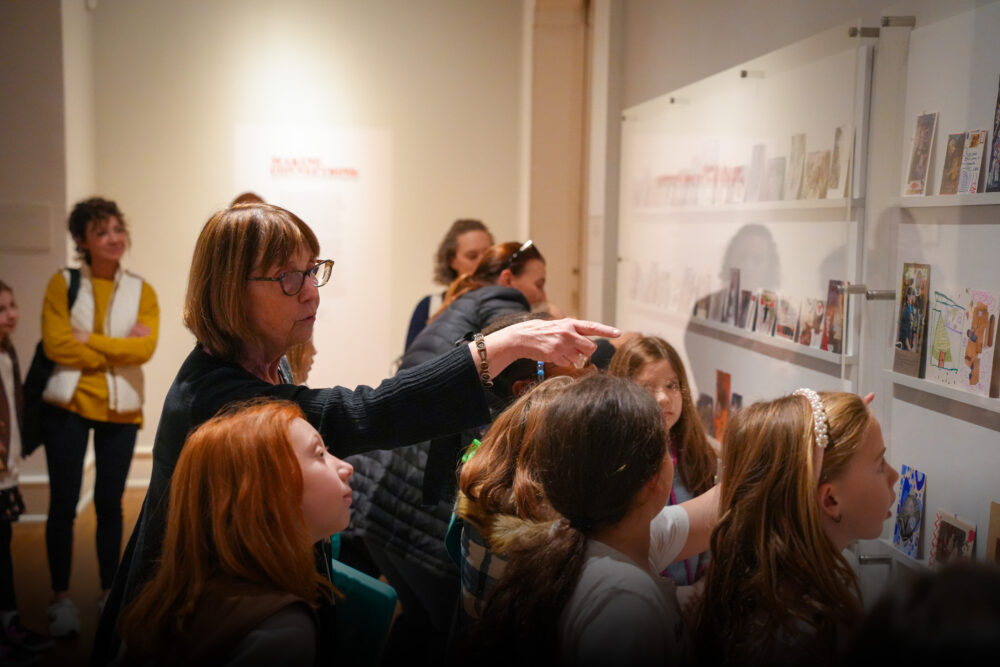
Mint docent Susan Catterall gives a group tour at Mint Museum Randolph.
By Michele Huggins
Having spent much of her career in law school and law firm libraries, Susan Catterall knew that she wanted to do something different when she retired. With an undergraduate degree in art history, she wanted to be more involved with arts. Thanks to a friend who was already a Mint Docent, she was introduced to Joel Smeltzer, head of school and gallery programs and docent liaison. She joined the Mint Docent program in 2017 and also volunteers in the library and archives department. Read on to learn more about her experience as a volunteer at the Mint.
How has volunteering at the Mint enriched your life?
I consider art to be fundamental to our lives. As it happens, in an unexpected way, my involvement at The Mint Museum has permitted me to fulfill my original goal of working in an art library. I think of this whenever I volunteer in the archives or encourage members of the Docent Research Committee to ask librarian Jennifer Winford for research assistance.
As a docent, I can share my passion for art and history with others. I have been fortunate to have formed firm friendships with other docents, especially with those in my entering class, and have learned much from seasoned docents and from the enthusiasm of new docents. We inspire each other.
I enjoy researching artists and art movements and have served on the Docent Research Committee for several years. Pursuing research put me in frequent contact with The Mint Museum librarians, including Joyce Weaver, Ellen Show, and Jennifer Winford. Eventually I eventually began volunteering for Ellen Show, director of library and archives, to learn more about archival work.
I have been honored to have had a behind-the-scenes glimpse of how long and how hard a curator works in bringing an exhibition to life and to observe the support that the library and archives department provides. I was privileged to assist in the processing of the Robert Ebendorf archives memorabilia and to have become better acquainted with Assistant Curator of Fashion, Craft, and Design Rebecca Elliot.
What is your favorite tour to give?
There are a number of tours which I enjoy, and I like being able to lead tours at Mint Museum Uptown and Mint Museum Randolph. Some of my favorites include: “The African American Experience Through Art,” “Learning to Look: Every Picture Tells a Story,” and the “Highlights Tour.”
Whenever I lead a tour, I feel as if I am encouraging individuals to appreciate and respond to different cultures and to perspectives that have been expressed through art. The learning and engagement staff, especially Joel Smeltzer, Maggie Mauldin. and Kassidy Childs, are continually developing creative tours and improving processes. Docents add to the success of a tour, not only by being prepared, but by our ability to read the audience, and adjust and cater the tour to them.
Do you have a favorite work in the Mint’s collection? If so, what makes it your favorite?
I enjoy the story behind the work of art, whether it’s the life of the individual artist, the process of making the piece, or the historic setting in which it was created. So, I have many favorites. However, I have two “go-to” pieces to which I frequently turn when engaging the tour audience. One is Hoss Haley’s White Ripple on view in on Level 3 in Craft + Design galleries. We discuss blacksmithing skills, environmental concerns regarding the recycling and repurposing of “white goods,” as well as the science behind the craft. I will often ask for a volunteer who has a strong, steady voice to walk the length of the piece. The remaining group can hear how the metal ripples shorten and lengthen the soundwaves, which begin to resemble a French police siren.
I also use Lonely Vigil by William Herbert Dunston by having the tour participants look carefully and tell me what is going on in the painting. I begin by having them stand on the other side of the room and describe the “big picture.” Then I ask the group to move forward and observe how other details emerge. We also discuss how artists’ fascination with the Old West helped shape American Art.
What do you wish more people knew about volunteering at the Mint?
What I most wish that people knew is that the docent corps is made of up of so many amazing and talented individuals. We are artists, professors, art educators, teachers, writers, editors, actors, gardeners, lawyers, librarians, bilinguists and so much more. We learn from each other and enjoy sharing our experiences and engaging our audiences.
Several years ago, a docent colleague and I created an acronym based on the word “MINT” to illustrate museum manners and rules for school students. For me, the “T” stands for “teaching each other.” I tell students that I may know about the art within the museum, but I depend on them to teach me new aspects through their eyes and experiences. I feel the same way about my docent colleagues.
Michele Huggins is associate director of marketing and communications at The Mint Museum.